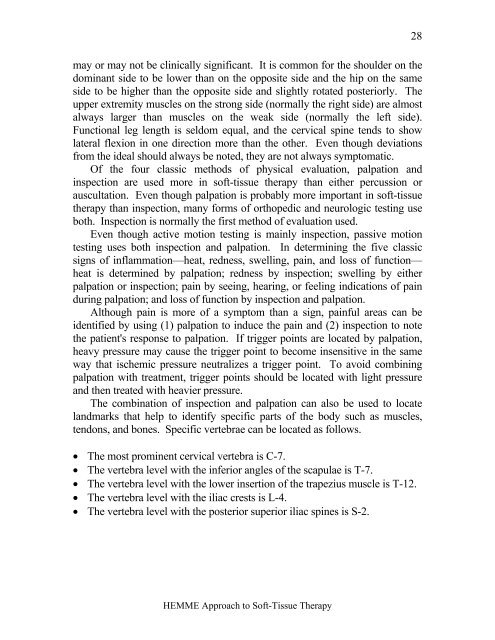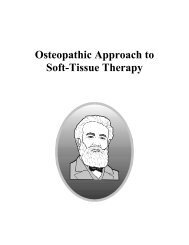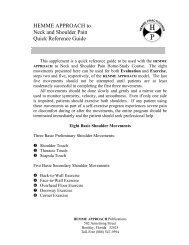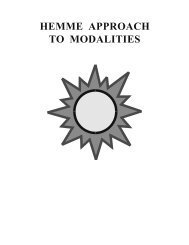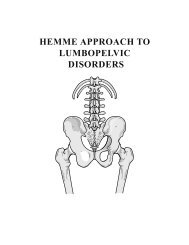HEMME APPROACH TO SOFT-TISSUE THERAPY
HEMME APPROACH TO SOFT-TISSUE THERAPY
HEMME APPROACH TO SOFT-TISSUE THERAPY
Create successful ePaper yourself
Turn your PDF publications into a flip-book with our unique Google optimized e-Paper software.
may or may not be clinically significant. It is common for the shoulder on the<br />
dominant side to be lower than on the opposite side and the hip on the same<br />
side to be higher than the opposite side and slightly rotated posteriorly. The<br />
upper extremity muscles on the strong side (normally the right side) are almost<br />
always larger than muscles on the weak side (normally the left side).<br />
Functional leg length is seldom equal, and the cervical spine tends to show<br />
lateral flexion in one direction more than the other. Even though deviations<br />
from the ideal should always be noted, they are not always symptomatic.<br />
Of the four classic methods of physical evaluation, palpation and<br />
inspection are used more in soft-tissue therapy than either percussion or<br />
auscultation. Even though palpation is probably more important in soft-tissue<br />
therapy than inspection, many forms of orthopedic and neurologic testing use<br />
both. Inspection is normally the first method of evaluation used.<br />
Even though active motion testing is mainly inspection, passive motion<br />
testing uses both inspection and palpation. In determining the five classic<br />
signs of inflammation—heat, redness, swelling, pain, and loss of function—<br />
heat is determined by palpation; redness by inspection; swelling by either<br />
palpation or inspection; pain by seeing, hearing, or feeling indications of pain<br />
during palpation; and loss of function by inspection and palpation.<br />
Although pain is more of a symptom than a sign, painful areas can be<br />
identified by using (1) palpation to induce the pain and (2) inspection to note<br />
the patient's response to palpation. If trigger points are located by palpation,<br />
heavy pressure may cause the trigger point to become insensitive in the same<br />
way that ischemic pressure neutralizes a trigger point. To avoid combining<br />
palpation with treatment, trigger points should be located with light pressure<br />
and then treated with heavier pressure.<br />
The combination of inspection and palpation can also be used to locate<br />
landmarks that help to identify specific parts of the body such as muscles,<br />
tendons, and bones. Specific vertebrae can be located as follows.<br />
• The most prominent cervical vertebra is C-7.<br />
• The vertebra level with the inferior angles of the scapulae is T-7.<br />
• The vertebra level with the lower insertion of the trapezius muscle is T-12.<br />
• The vertebra level with the iliac crests is L-4.<br />
• The vertebra level with the posterior superior iliac spines is S-2.<br />
28<br />
<strong>HEMME</strong> Approach to Soft-Tissue Therapy


